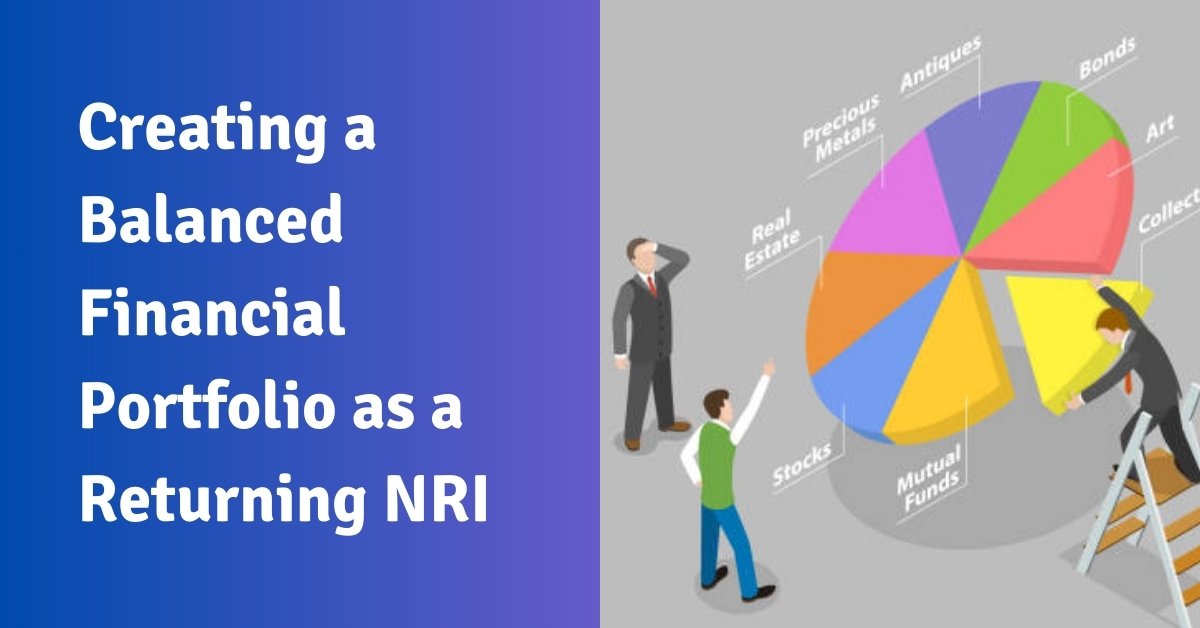As a Non-Resident Indian (NRI) returning to India, one of the most crucial aspects of your financial planning is creating a balanced investment portfolio. A well-diversified portfolio not only helps you manage risk but also enables you to achieve your financial goals effectively. In this blog post, we will explore the key considerations and strategies for building a balanced financial portfolio as a returning NRI.
Assess Your Financial Goals and Risk Tolerance
The first step in creating a balanced portfolio is to clearly define your financial goals. Are you saving for retirement, your children’s education, or a major purchase? Understanding your short-term and long-term objectives will help you determine the appropriate asset allocation and investment horizon. Additionally, assess your risk tolerance – the level of market volatility you are comfortable with. This will guide you in selecting investment instruments that align with your risk profile.
Diversify Across Asset Classes
Diversification is the cornerstone of a balanced portfolio. As a returning NRI, you have access to a wide range of investment options in India. Spread your investments across different asset classes such as equities, fixed income, real estate, and commodities. Each asset class has its own risk-return characteristics, and diversifying helps mitigate the impact of market fluctuations on your overall portfolio. Consider investing in a mix of stocks, bonds, mutual funds, and other financial instruments to create a well-rounded portfolio.
Understand the Indian Financial Landscape
As an NRI, you may have been accustomed to investing in foreign markets. However, the Indian financial landscape has its own unique characteristics and regulations. Familiarize yourself with the various investment avenues available in India, such as the National Pension System (NPS), Public Provident Fund (PPF), Employee Provident Fund (EPF), and Tax-saving mutual funds (ELSS). Understand the tax implications and regulatory requirements associated with each investment option to make informed decisions.
Consider the Currency Risk
When you return to India, your foreign currency assets may be subject to currency risk. Fluctuations in exchange rates can impact the value of your investments. To mitigate this risk, consider diversifying your portfolio across currencies. You can invest in Indian assets that provide exposure to international markets, such as international mutual funds or exchange-traded funds (ETFs). Additionally, maintain a portion of your portfolio in stable currencies like the US dollar to hedge against currency volatility.
Seek Professional Advice
Creating a balanced portfolio can be a complex task, especially for NRIs navigating the Indian financial landscape. It is highly recommended to seek the guidance of a qualified financial advisor who specialises in NRI investments. A professional can help you assess your financial goals, risk tolerance, and tax implications, and develop a customised investment strategy tailored to your unique circumstances. They can also provide valuable insights into market trends, regulatory changes, and investment opportunities.
Review and Rebalance Regularly
A balanced portfolio is not a one-time exercise. Regular monitoring and rebalancing are required to ensure that your investments remain aligned with your goals and risk tolerance. As market conditions change and your personal circumstances evolve, it is essential to review your portfolio periodically. Rebalancing involves adjusting the allocation of your investments to maintain the desired level of diversification and risk. This helps you stay on track and make necessary adjustments to optimise your portfolio’s performance.
Incorporate Tax Planning
As a returning NRI, tax planning is an integral part of creating a balanced portfolio. India has a complex tax system, and it is crucial to understand the tax implications of your investments. Consult with a tax professional to explore tax-efficient investment options and strategies. For example, you can consider investing in tax-saving instruments like Equity Linked Savings Schemes (ELSS) or insurance policies that offer tax benefits. Effective tax planning can help you maximise your after-tax returns and achieve your financial goals more efficiently.
Conclusion
Creating a balanced financial portfolio as a returning NRI requires careful planning, diversification, and regular review. By assessing your financial goals, understanding the Indian financial landscape, diversifying across asset classes, and seeking professional advice, you can build a robust portfolio that withstands market volatility and helps you achieve your financial aspirations. Remember to stay informed, adapt to changing circumstances, and make informed investment decisions based on your unique needs and risk tolerance. With a well-balanced portfolio, you can secure your financial future and enjoy a smooth transition back to India.
Disclaimer: The information provided here is for educational and informational purposes only and should not be construed as financial, legal, or tax advice. Consult with a qualified professional before making any investment decisions. We do not accept any liability for errors or omissions in this information nor any direct, indirect, or consequential losses arising from its use.
Frequently Asked Questions (FAQs)
1. What is a balanced financial portfolio, and why is it important for returning NRIs?
Ans – A balanced financial portfolio is a well-diversified investment mix that spreads your money across various asset classes, such as equities, fixed income, real estate, and commodities. It helps manage risk, optimise returns, and achieve your financial goals as a returning NRI.
2. How can I assess my risk tolerance while creating a balanced portfolio?
Ans – To assess your risk tolerance, consider factors such as your age, investment horizon, financial goals, and emotional ability to handle market fluctuations. You can also take risk assessment questionnaires or consult with a financial advisor to determine your risk profile.
3. What are some key asset classes to consider for diversification in India?
Ans – Some key asset classes to consider for diversification in India include equities (stocks), fixed income (bonds, deposits), real estate, commodities (gold, silver), and alternative investments like mutual funds and exchange-traded funds (ETFs).
4. How can returning NRIs mitigate currency risk in their investment portfolio?
Ans – Returning NRIs can mitigate currency risk by diversifying their portfolio across currencies, investing in Indian assets with international exposure (e.g., international mutual funds or ETFs), and maintaining a portion of their portfolio in stable currencies like the US dollar.
5. Why is seeking professional advice important for returning NRIs creating a balanced portfolio?
Ans – Seeking professional advice from a qualified financial advisor specialising in NRI investments can help you navigate the complex Indian financial landscape, assess your goals and risk tolerance, and develop a customised investment strategy tailored to your unique circumstances.
6. How often should I review and rebalance my investment portfolio?
Ans – It is recommended to review your investment portfolio at least annually or whenever there are significant changes in your personal circumstances or market conditions. Rebalancing helps maintain the desired level of diversification and risk alignment.
7. What are some tax-efficient investment options for returning NRIs in India?
Ans – Some tax-efficient investment options for returning NRIs in India include Equity Linked Savings Schemes (ELSS), Public Provident Fund (PPF), National Pension System (NPS), and tax-saving fixed deposits. Consult with a tax professional to explore the best options based on your specific situation.
8. Can I invest in international markets as a returning NRI?
Ans – Yes, returning NRIs can invest in international markets through Indian mutual funds or ETFs that have exposure to foreign securities. However, it is essential to understand the regulatory requirements and tax implications of investing in international markets from India.
9. How can I align my investment portfolio with my financial goals?
Ans – To align your investment portfolio with your financial goals, start by clearly defining your short-term and long-term objectives. Then, select investment instruments with risk-return characteristics that match your goals and investment horizon. Regularly review and adjust your portfolio to ensure it stays on track with your goals.
10. What should I do if my investment portfolio is not performing as expected?
Ans – If your investment portfolio is not performing as expected, avoid making impulsive decisions based on short-term market fluctuations. Review your portfolio with a financial advisor to identify areas for improvement, such as adjusting your asset allocation, rebalancing, or exploring alternative investment options. Stay focused on your long-term goals and make informed decisions based on sound financial principles.





